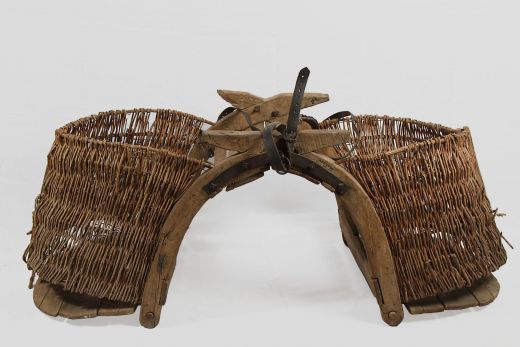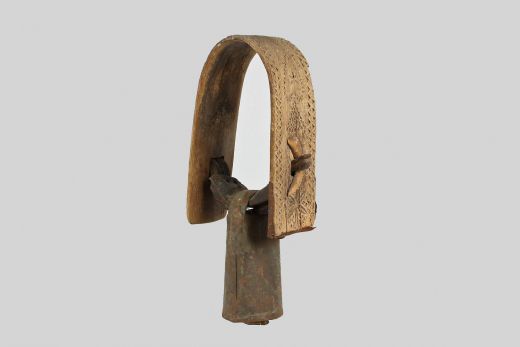Agriculture in the museum collections of the Moyen Verdon
Located at the Mediterranean and Alpine limit, in the middle mountain region with cold climate in winter and dry in summer, subsistent agriculture, essentially based on local cereals and pulses cultivated on the terraced mountain slopes, has always been practiced in Moyen Verdon. Incapable of growing above an altitude of 1000 meters high, the vines reaches its growth's limit there. French vineyards were destroyed several times, affected by the phylloxera pest which broke out at the end of the 19th century.
Olive trees did not exist at the time. Since the exploration of inner farmland in the 17th and 18th centuries, cultivating orchards has allowed exporting prunes, apples and pears to Basse Provence. Lavender first appeared in the 20th century. At the time, sheep farming prevailed, and progressively small local sheep flocks farmed for mutton, dairy, and wool, were joined by the transhumance flocks from the Var region coming to graze in the mountain pastures of Teillon, Bernarde, Aup and Mourre de Chanier located in the pre-alpine massifs. Our collections reflect these various realities and their development.
We have deliberately chosen not to include farm machinery dating from the 20th century in our collections as it appeared quite late in our region, and its appearance coincides with the decline and even abandonment of agriculture as such. On the opposite, we prefer bringing forward the permanence of age-old techniques, as the age of certain tools disappeared elsewhere (watering shovel, capstan winch, etc.) and the objects of “rural invention” referring to that peasant society of economy and recycling where everything had to serve as long as possible and cost nothing.
Our collections of hand-held soil cultivation and harvesting tools were mostly locally or regionally produced by Estoublon, Cuébris, Seillans tool-makers. As to ard ploughs, Moyen Verdon is located on the boundary between the bow ard (the provencal type) and the body ard (the south-alpine type). After the First World War (1914-1918), the latter was replaced by a locally made two-handed ristle, a coulter-like implement used to reach greater depth. Until the Second World War (1939-1945) it was pulled out by a yoke of oxen of local breeds. Until the same period, wheat was reaped with the help of a sickle. In the 20th century, necessitating flat and managed areas, the usage of a roller became popular only in the valley bottoms.
Hay, wheat crops, fruits, wood, and manure were carried by mules or donkeys.

Num Inventaire : 2012.0.126
Dénomination : bât de mulet
Détail Matières et techniques : bois ; peau ; fer
Dimensions : L.65, l.84, H.50
Précisions sur la description : Selle grossière que l'on place sur le dos des bêtes de somme pour le transport de fardeaux ne nécessitant pas un attelage.
Description de l'acquisition : Objet donné à l'association par la famille Casa-Trotabas, en 1992. Il provient de Beauvezer.

Num Inventaire : 2012.0.127
Dénomination : caisse à fumier
Détail Matières et techniques : bois ; osier ; corde
Dimensions : L.155, l.59, H.58,50,
Précisions sur la description : Système de portage de charge en bois. Aux arceaux en bois sont fixés deux grosses corbeilles en osier dont le fond en planche est amovible. On remplit les corbeilles à l'aide d'un panier spécial et pour vider la charge, on tire sur une cordelette ouvrant le fond. L'ensemble se pose sur le dos d'une bête.
Description de l'acquisition : Objet donné à l'association par Mme Corporandy-Liabeuf, de Bouchanières, hameau de Guillaumes, et M. Clary André, de Péone, en mai 1993.

Num Inventaire : 2012.1.3
Dénomination : sonnaille de troupeau
Détail Matières et techniques : bois ; métal ; cuir ; os
Dimensions : H.34, l.9, L.15.5, Pds.858
Précisions sur la description : Clochette qu'on attache au cou des bêtes. La sonnaille est constituée d'un collier appelé cambis, large morceau de bois sculpté entourant le coup de l'animal. La cloche est constituée d'une feuille de métal pliée et battue. Le son est produit par un battant en os relié à la sonnaille par une lanière de cuir.
Description de l'acquisition : Objet donné à l'association par Mme. Monique Audibert, de Brans - Castellane.










